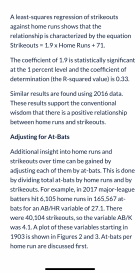Consecutive free throws do follow a bell cure. By not mapping consecutive misses, you make the left portion of the bell curve invisible. You can easily shoot poorly enough that the middle of the bell curve is in the negative portion of the graph that you have not mapped. You don’t get to cut the bell curve in half, and then declare that because it only slopes downward on one side that it isn’t a bell curve. It is a bell curve, and your chosen to ignore one side of it. Graphing consecutive misses as negative hits makes the rest of the bell curve visible. There’s a peak in the middle, and it turns downward on both the positive and negative sides, and neither sides ever reaches zero, because if you performed the free throw an infinite number of times, you have a portion of the infinity sequence in which you missed an infinite number of times, and you would have a portion of the sequence in which you hit an infinite number of consecutive times. The Y axis of the graph represents the percentage of the sequence that you hit or missed X number consecutively. Yes you can consecutively hit infinitely, and consecutively miss infinitely, and still be within the bounds of the infinite sequence. Infinity fits into infinity an infinite number of times, but you can still derive percentages and distributions from that.
Consecutive misses wouldn’t be something we are interested in graphing though. First, consecutive misses are something we could make as high an incidence as we chose, because we can guarantee misses if we wanted them, just like we can shoot bad groups or miss the target. There is no statistical value in measuring something susceptible to a certain outcome. Secondly, intentionally running up a string of misses does not reveal how many hits a good shooter is actually capable of making.
But more importantly, if they were considered important, in my example, misses were already a trapped and accounted for value. Every time the shooter missed a free throw, he had to start over, and the premise was that he statistically was capable of reaching a certain number of hits consecutively, half of the time he began shooting. My logical conclusion is that the other half of the times that he does not reach that number, an easier number to hit, 1, 2, 3, 4, not a harder number, is going to dominate that half of his tries.
A bell curve is simply not applicable to everything we do. If you could hit 5 half the times you began, then it would suggest that you can shoot 4 and 6 consecutive free throws equally frequently. And 3 and 7. This does not comport with experience. But if you made misses the opposite side of a bell curve, you’d still have a constant downward slope on consecutive hit ability.











